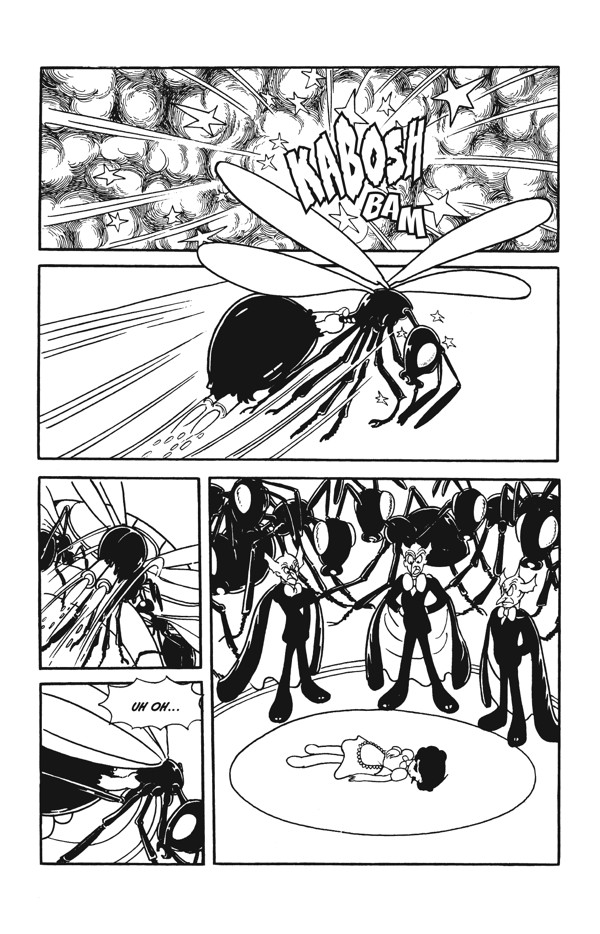Comic Book Review: Astro Boy: Omnibus Volume 4
Coming from Dark Horse this week, we have the manga collection of [easyazon_link identifier=”161655956X” locale=”US” tag=”bounintocomi-20″]Astro Boy: Omnibus Volume 4[/easyazon_link], by Osamu Tezuka, released 17 years after his passing. Dark Horse originally published the works in 2002, translated by Frederik L. Schodt. Given the messages that the works convey, the lessons that are being explored in the comics are just as important today as they were during their original publication in Japan.
[easyazon_image align=”center” height=”500″ identifier=”161655956X” locale=”US” src=”http://boundingintocomics.com/wp-content/uploads/2016/06/51lVXmAYVJL.jpg” tag=”bounintocomi-20″ width=”321″]
A work by Japanese mangaka (manga artist) Osamu Tezuka (手塚 治虫), a majority of Astro Boy Omnibus Volume 4 was originally published in Japan in the mid 60’s. Along with being a mangaka, Tezuka was also a cartoonist, animator, film producer, and activist. He was inspiration for both Akira Toriyama (Dragon Ball) and Hayao Miyazaki (Spirited Away), being called both the Father of Manga and God of Manga.
There is a lot that can be said of Osamu Tezuka, about how on his deathbed he begged to keep working. Or how he was also a soldier in WWII, who was reprimanded constantly for drawing cartoons rather than performing his duties. Or how he was an outstanding critic of nuclear proliferation, being one who experienced first-hand the fire bombings of Osaka, which gave him further perspective on the destruction that happened to both Nagasaki and Hiroshima. Yet in this collection of Astro Boy we see some of his beliefs brought to life in the acts of a robot boy, trying desperately to do good in a world that is locked in a battle between the extremes of good and evil.
Tezuka could be compared to a revolutionary in his thought process – yet instead of using books like Hobbes or Locke, or letters like the apostle Paul or Martin Luther King Jr., Tezuka chose his mangas as his microphone to voice his concerns over global problems. Originally, Astro Boy was never meant to be a hero. He was an robot created by Professor Tenma, built to replace the son he had recently lost in a car accident. Realizing Astro Boy couldn’t fill the void of the son he lost, Tenma abandons him, selling him off to circus performers. Astro Boy eventually gets picked up by Professor Ochanomizu of the Ministry of Science, and struggles to be accepted by society despite serving his community with acts of heroism.
In our first story, Tezuka explores the deeper issue of self-identity and acceptance of one’s nature. Astro Boy is forced to take on an older body, as robots do not age, and society wants robots to be more human-like in that regard. This raises the issue of perspective – how society accepts or rejects people versus the individual’s acceptance of themselves.
The next issue covers the acquisition of power, and explores the virtues of sacrifice, betrayal, and choosing the greater good over one’s own interests. Subsequent issues in this collection explore other themes as well – like what really defines someone as evil, religion versus practicality, the insignificance of race when deeds are considered, the dangers of using science for evil pursuits, and society’s obsession with violence and the consequences.
In this 688 page omnibus, the art is simple, cartoonish, and shows progression as the publication continues. Although there is cheesy humor salted throughout the plot, in the dialogue, and the art, some may argue that the art style may be a little too simple for older audiences. This doesn’t distract the reader from the importance of the overall message Tezuka is trying to get across to audiences.
Earlier issues seem to have a simpler style to them, while later issues show more detail in the scenery and in the protagonists. It is much like the progressing art style of Tite Kubo in Bleach. However, the titular character and other main characters are drawn consistently. Audiences can easily point out Astro Boy as well as the supporting cast.
There isn’t much more one could say regarding the art style because it is one of the innovative titles in Japan that really kickstarted the manga industry, and the messages that were carried throughout the series seemed to be ahead of its time. The cover shouts color, and if there was a colored version of this comic, it would just add to the brilliance of the work.
The Verdict
As religiously as I read comics from the U.S., I read manga as well. To see [easyazon_link identifier=”161655956X” locale=”US” tag=”bounintocomi-20″]Astro Boy Omnibus Volume 4[/easyazon_link] come out from Dark Horse and to read some issues that many mangaka of today draw their inspiration from makes me realize that there was a work ethic and thought process in Osamu Tezuka that they probably all strive for in their own works. It is quite a tribute to a man that literally gave his life to his work because he saw it was the greater need. There is little criticism I can say of the title other than the childish nature, but the stories bring messages that are timeless, and have something for everyone.
More About:Comic Book Reviews Reviews



